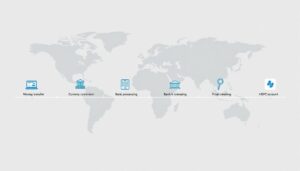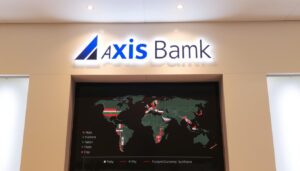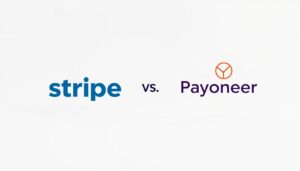Did you know that cross-border transactions account for over $150 billion annually in India alone? With such a massive scale, understanding the costs involved is crucial for both businesses and individuals. Whether you’re sending money abroad or managing forex needs, knowing the fee structure can save you significant amounts.
This guide dives deep into the ecosystem of cross-border transactions, focusing on RBI-compliant processes under the Liberalized Remittance Scheme (LRS). We’ll break down direct charges and hidden costs to help you make informed decisions.
By comparing traditional banking solutions with emerging fintech options, this article provides actionable insights to optimize your international money transfers. Stay ahead with a clear understanding of how fees impact your total transaction value.
Key Takeaways
- Comprehensive analysis of cross-border transaction fees.
- Focus on RBI-compliant processes under LRS.
- Breakdown of direct and hidden costs.
- Comparison of traditional banking vs. fintech solutions.
- Actionable insights for businesses and individuals.
Introduction to HDFC Bank International Payment Charges
Global transactions often come with hidden fees that can significantly impact your total costs. Understanding HDFC international transactions is key to managing global finances effectively. Whether you’re sending or receiving funds, these transfers involve multiple layers of fees that can add up quickly.
HDFC plays a significant role in India’s outward remittance market. Their services are widely used, but the cost structure can be complex. Three primary components make up the total charges: flat fees, GST, and exchange markups. Each of these can affect the final amount you pay or receive.
Common pain points include intermediary bank deductions and unpredictable final amounts. For example, a $1,000 transfer might result in a ₹2,570 loss due to rate markups. This highlights the importance of understanding the fee structure before initiating any transaction.
All these transactions are governed by RBI guidelines, ensuring compliance and transparency. Knowing these regulations can help you navigate the process more effectively and avoid unnecessary costs.
Understanding HDFC Bank’s International Transaction Fees
Navigating the costs of sending money abroad can be complex and often confusing. Whether you’re managing personal finances or handling business transactions, understanding the fee structure is crucial. This section breaks down the costs associated with outward and inward remittances, helping you make informed decisions.
Outward Remittance Costs
When sending money abroad, the fees are structured based on the transaction amount. For transfers up to $500, a flat fee of ₹500 plus 18% GST applies. For amounts above $500, the fee increases to ₹1,000 plus GST. This tiered pricing ensures that smaller transactions remain affordable while larger ones cover additional processing costs.
Additional factors can influence the total cost, such as SWIFT charges and correspondent bank fees. These third-party costs can vary, so it’s essential to account for them when planning your transfer.
Inward Remittance Costs
Receiving money from abroad also comes with its own set of fees. One of the primary costs is the exchange rate markup, which typically ranges between 2% and 3.5%. This markup can significantly impact the final amount you receive, especially for larger transactions.
Differences in handling domestic and NRI accounts can also affect the total cost. Understanding these nuances can help you choose the right account type for your needs.
- Tiered Pricing: Fees vary based on the transfer amount, with ₹500-1,000 base charges plus GST.
- Exchange Rate Markup: Inward transfers may include a 2-3.5% markup, affecting the final amount.
- Third-Party Fees: SWIFT and correspondent bank charges can add to the total cost.
- Account Differences: Domestic and NRI accounts may have varying fee structures.
Exchange Rate Markups and Their Impact
Exchange rate markups are a hidden cost that can affect your cross-border payments. These markups are applied on top of the mid-market rate, increasing the cost of currency conversion. Understanding how they work is essential to minimize losses.
For example, if the mid-market rate is ₹85.73 and the applied rate is ₹83.16, the rate markup is 3%. On a $1,000 transfer, this results in a loss of ₹2,570. Such markups can add up, especially for frequent transactors.
The mechanics of currency spread application are straightforward. Financial institutions add a margin to the mid-market rate, which becomes the final exchange rate offered to customers. This margin is their profit, but it increases your costs.
- Live Example: A 3% markup equals a 2.99% effective fee on your transaction.
- Cumulative Impact: Frequent transfers can lead to significant losses over time.
- Interbank Comparison: Real conversion scenarios show higher costs compared to interbank rates.
- Regulatory Transparency: Guidelines ensure institutions disclose markups, but understanding them is up to you.
Comparing these rates with interbank benchmarks reveals the true cost. For instance, a mid-market rate of ₹85.73 vs. an applied rate of ₹83.16 highlights the 3% markup. This difference underscores the importance of choosing the right service provider.
Regulatory bodies mandate transparency in markup disclosures. However, it’s your responsibility to analyze and understand these costs. Being informed helps you make better decisions and save money on global transactions.
HDFC Bank’s Processing Time for International Payments
Efficiency in cross-border transactions is critical for businesses and individuals alike. Knowing the transfer time helps you plan better and avoid unnecessary delays. Typically, these transactions take 2-3 working days if initiated before 2:30 PM. Requests made after this cut-off are processed the next working day.
Country-specific variations can affect delivery timelines. For instance, transfers to some regions may take longer due to local banking holidays or processing delays. Always check the destination country’s holiday calendar to avoid surprises.
Tracking your payment is straightforward. You can use SWIFT MT103 for detailed updates or check the status via in-app tools. These mechanisms provide real-time insights into your transaction’s progress.
- Cut-off Times: Same-day processing requires requests before 2:30 PM.
- Country Variations: Delivery timelines differ based on the destination.
- Tracking Options: SWIFT MT103 or in-app status checks for real-time updates.
- Holiday Impact: Local holidays can delay processing and delivery.
- Expedited Options: Some services offer faster processing for urgent needs.
Understanding these factors ensures smoother transactions and better financial planning. Whether you’re managing personal finances or running a business, staying informed about the process can save you time and effort.
HDFC Bank’s Forex Services and Associated Fees
Managing foreign currency needs efficiently is essential for seamless global transactions. Whether you’re traveling abroad or handling business payments, understanding the associated costs can save you time and money. This section explores the fee structure for forex card loads and currency cheque collections, helping you make informed decisions.
Forex Card Loads
Loading a forex card is a convenient way to manage your currency needs while traveling. The fees for this service typically range from ₹200 to ₹500, plus applicable taxes. This cost structure ensures that smaller transactions remain affordable while larger ones cover additional processing expenses.
For frequent travelers, forex cards offer a secure and efficient way to carry multiple currencies. However, it’s essential to factor in the loading fees when planning your budget.
Currency Cheque Collections
Collecting cheques in foreign currencies involves specific charges. The standard fee is 0.25% of the cheque amount, with a minimum of ₹250. Additionally, a ₹50 courier charge applies for processing. These fees ensure that your cheques are handled securely and efficiently.
For businesses or individuals receiving frequent payments, understanding these costs can help optimize your financial planning. Bulk transactions may also qualify for discounts, making this option more cost-effective for high-volume users.
- Multi-Product Fee Matrix: Compare costs for cards, drafts, and cheque services to choose the best option.
- FCY Demand Draft Issuance: Understand the cost breakdown for issuing foreign currency drafts.
- Exception Handling: Returned cheques incur a $10 fee per instance.
- FIRC Documentation: Charges of ₹200 per certificate for foreign inward remittance documentation.
- Bulk Discounts: Explore discounts available for high-volume transactions.
Goods and Services Tax (GST) on Currency Exchanges
Understanding GST on currency exchanges is essential for managing cross-border costs effectively. This tax applies to various financial services, including currency conversions and remittances. The GST structure is divided into slabs, ranging from 0.18% to 0.018%, with minimum and maximum amounts of ₹45 and ₹10,800, respectively.
The calculation methodology is straightforward. For example, a transaction with a taxable value of ₹50,000 incurs a GST of ₹90 (0.18%). Larger transactions, such as ₹1,00,000, attract a GST of ₹180. These slabs ensure that smaller transactions remain affordable while larger ones contribute proportionally.
Businesses can benefit from input tax credit eligibility. This allows them to offset GST paid on inputs against their output tax liability. For high-frequency users, this can significantly reduce the overall tax burden. Additionally, tax optimization strategies, such as consolidating transactions, can further minimize costs.
- GST Slabs: 0.18%-0.018% with ₹45-10,800 min/max.
- Input Tax Credit: Businesses can offset GST paid on inputs.
- Tax Optimization: Consolidate transactions to reduce costs.
- Compliance: Ensure proper GST invoice generation for audits.
Comparing GST with other banking service tax structures reveals key differences. For instance, some services may have lower tax rates but higher base fees. Understanding these nuances helps in choosing the most cost-effective option.
Compliance is crucial. Proper GST invoice generation ensures transparency and avoids penalties. Always verify the tax details on your invoices to ensure accuracy. By staying informed, you can manage your finances more effectively and avoid unnecessary expenses.
Comparing HDFC Bank’s Charges with Other Banks
When it comes to global transactions, not all financial institutions are created equal. Fees and exchange rates can vary significantly, impacting the total cost of your international transfers. Understanding these differences is crucial for making informed decisions.
For instance, HDFC applies a 3% markup on the mid-market rate, while competitors often charge between 1% and 2%. This difference can add up, especially for larger transactions. Comparing these rates helps you identify cost-effective options.
Public sector banks typically offer lower fees but may have longer processing times. Private banks, on the other hand, provide faster services but at higher costs. Foreign banks often use corridor-specific pricing, tailoring fees based on the destination country.
Digital-first banks are disrupting the market with innovative pricing models. These platforms often offer lower fees and competitive exchange rates, making them a popular choice for tech-savvy users.
To evaluate the true cost, consider the total cost of ownership (TCO). This framework includes all fees, exchange markups, and hidden costs. For example, a case study comparing USD-EUR transfers across five major banks revealed significant differences in TCO.
- Public vs. Private Banks: Public banks are cheaper but slower; private banks are faster but costlier.
- Corridor-Specific Pricing: Foreign banks adjust fees based on the destination country.
- Digital-First Models: Innovative platforms offer lower fees and competitive rates.
- TCO Framework: Evaluate all costs to identify the most cost-effective option.
- Case Study: USD-EUR transfers show significant TCO differences across banks.
By comparing these factors, you can choose the best option for your transfer india needs. Whether you prioritize cost, speed, or convenience, understanding the fee structures ensures you get the most value.
Hidden Costs in HDFC Bank’s International Transfers
Hidden costs in global transactions can catch even the most prepared individuals off guard. While upfront pricing may seem straightforward, additional fees often lurk beneath the surface. These can significantly impact the total cost of your money transfers.
- Correspondent Bank Fees: Third-party banks involved in the process may deduct fees, which are not reflected in upfront pricing.
- Exchange Rate Markups: Financial institutions often apply a margin to the mid-market rate, increasing your costs.
- Processing Delays: Extended timelines can lead to indirect costs, especially for time-sensitive transactions.
- Regulatory Compliance Charges: Ensuring adherence to guidelines may incur additional fees.
- Funds Recovery Costs: Excessive deductions may require a recovery process, adding to your expenses.
- Consumer Protection Fees: Mechanisms under RBI guidelines may involve nominal charges.
To avoid surprises, follow a pre-transaction cost analysis checklist. Review all potential fees, compare exchange rates, and confirm processing timelines. This proactive approach ensures transparency and helps you budget effectively.
If you encounter excessive deductions, the funds recovery process is straightforward. Contact your service provider with detailed documentation to initiate a refund. Regulatory disclosure requirements mandate transparency, so institutions must provide clear fee breakdowns.
Consumer protection mechanisms under RBI guidelines safeguard your interests. These include dispute resolution processes and fee caps for specific services. Staying informed about these protections empowers you to make better financial decisions.
Alternative Solutions for International Money Transfers
Exploring alternative solutions for global financial transactions can unlock significant savings and efficiency. Traditional methods often come with high fees and delays, but modern neo-banking platforms offer competitive advantages. These solutions are designed to streamline the process, reduce costs, and provide faster turnaround times.
Exploring Karbon FX as a Solution
Karbon FX stands out as a reliable option for international money transfers. Unlike traditional methods with markups of 2-3.5%, Karbon FX offers near-zero markups. This ensures that more of your money reaches its destination. Additionally, their processing time is significantly faster, with transfers completed in 24-48 hours compared to the 2-4 days typical of conventional systems.
One of the key advantages of Karbon FX is its real-time mid-market rate feature. This ensures that users get the best possible exchange rate without hidden fees. For businesses or individuals with high forex needs, this can translate into substantial savings. A case study revealed annual savings of ₹1.2L on ₹50L in forex transactions.
- Hybrid Model: Combines a digital platform with physical support for seamless transactions.
- Compliance Parity: Meets all regulatory standards, ensuring secure and transparent transfers.
- Real-Time Tracking: Provides a dashboard for monitoring transactions, offering peace of mind.
Karbon’s integration with multi-currency transfers streamlines the process, reducing errors and delays. Their automated error detection system ensures pre-emptive fixes, minimizing disruptions. This makes Karbon FX a robust alternative for those looking to optimize their transfer money experience.
Tips to Minimize HDFC Bank’s International Payment Charges
Optimizing global financial transactions requires strategic planning and awareness of cost-saving techniques. By implementing proven strategies, you can reduce unnecessary expenses and maximize the value of your international transactions. Here are five actionable tips to help you save on cross-border payments.
1. Batch Transfers Over $500: Consolidating multiple payments into a single transaction can reduce per-unit fees. For example, sending $1,000 in one transfer is more cost-effective than two $500 transfers. This approach is ideal for businesses with regular sending money needs.
2. Timing Markets for Favorable Rates: Monitor exchange rates to identify the best time for your transfer. Small fluctuations can lead to significant savings, especially for larger amounts. Tools like rate alerts can help you stay informed.
3. Negotiation Tactics for High-Volume Users: If you frequently transfer large sums, negotiate with your service provider for discounted rates. Many institutions offer tailored pricing for high-volume clients.
4. Multi-Currency Account Utilization: Holding funds in multiple currencies can reduce conversion fees. This strategy is particularly useful for businesses with diverse international transaction needs.
5. GST Optimization Through Invoice Timing: Align your transfers with GST invoice cycles to maximize input tax credits. This approach can significantly reduce your overall tax burden.
By adopting these strategies, you can minimize costs and enhance the efficiency of your global financial operations. Whether you’re managing personal finances or running a business, these tips provide actionable insights to optimize your hdfc transfer experience.
Conclusion
Modern alternatives to traditional methods offer substantial savings and efficiency. While HDFC Bank remains a reliable option, its lack of transparency in fee structures can lead to higher costs. Emerging digital platforms provide up to 60-70% cost savings, making them a compelling choice for global transactions.
When deciding between traditional and digital providers, consider three key criteria: cost, speed, and transparency. Emerging market trends highlight the growing preference for digital-first solutions due to their competitive rates and faster processing times.
Regulatory frameworks are increasingly emphasizing fee transparency, ensuring consumers can make informed decisions. A final cost-benefit analysis framework helps evaluate the true value of each option, balancing upfront costs with long-term savings.
By staying informed and exploring modern alternatives, you can optimize your international money transfers and achieve better financial outcomes.







